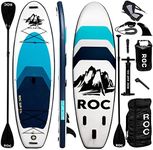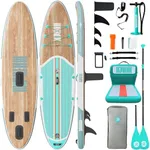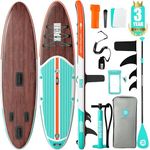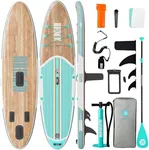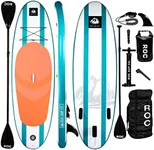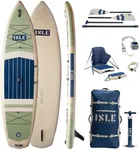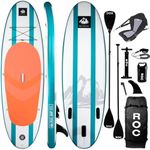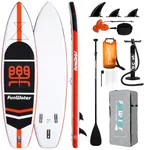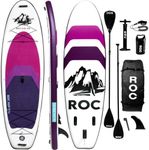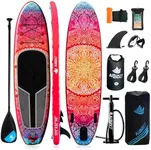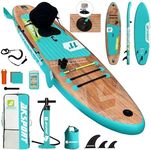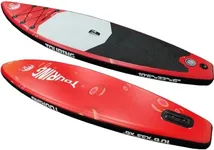Buying Guide for the Best Inflatable Paddle Boards
Choosing the right inflatable paddle board can make a big difference in how much you enjoy your time on the water. There are several key features to consider, and understanding how each one affects performance and usability will help you select a board that matches your needs and riding style. Think about how you plan to use the paddle board: will you mostly cruise on flat water, try a bit of surfing, go on longer touring trips, do yoga, or even bring along another person or pet? Knowing your goals will help you narrow down the many choices out there.Board LengthBoard length is the measurement from nose to tail of the paddle board. This is important because the length of the board affects stability, speed, and how easy it is to turn. Shorter boards (around 9-10 feet) are easier to maneuver and are usually chosen for surfing or for children. Medium-length boards (about 10-12 feet) offer a good balance of stability and speed and are great for general paddling and beginners. Longer boards (12-14 feet or more) are best for speed and tracking over longer distances, which makes them ideal for touring. Think about where and how you’ll use your board: for versatility or beginners, pick a medium length; for dedicated touring, go longer; for surfing or easy transport, go shorter.
Board WidthBoard width is measured from side to side at the widest part of the board. Width affects stability and speed: wider boards (about 32 inches or more) feel more stable and are good for beginners, yoga, or anyone who wants to bring a child, dog, or cool box onboard. Narrower boards (28-31 inches) are faster and more efficient through the water, but less stable, and are often chosen by experienced paddlers or racers. If you are new to paddle boarding or want maximum comfort, choose a wider board; if your goal is speed or performance, consider a narrower option.
Board ThicknessThickness impacts how much weight the board can carry and how rigid it feels when inflated. Most inflatable paddle boards are either 4, 5, or 6 inches thick. Thicker boards (6 inches) offer more buoyancy and stiffness, which is helpful for heavier paddlers, carrying extra gear, or practicing stability-focused activities like yoga. Thinner boards (4-5 inches) may sit lower in the water, are lighter to carry, and can be easier to maneuver, but they can flex more, especially with heavier riders. Consider your body weight and how much gear or company you’ll have—go thicker for more buoyancy and support, thinner for lightweight paddlers or those wanting a more traditional surf-board feel.
Weight CapacityWeight capacity tells you the maximum combined weight (rider plus any gear or passengers) that the board can safely support. This is crucial, because overloading the board makes it harder to paddle and control, and can cause it to sag in the middle. Weight limits vary greatly, from around 200 pounds for smaller boards to 400 pounds or more for larger, touring models. Always choose a board with a weight capacity that fits your anticipated load, including yourself, gear, and anyone or anything else you plan to bring along.
Board ShapeInflatable paddle boards come in different shapes, commonly all-around, touring, and specialty shapes like yoga or surf. All-around shapes have rounded noses and moderate width, making them suitable for most activities and skill levels. Touring boards have pointed noses and are usually longer, which improves speed and tracking in a straight line—great for covering distance. There are also specialized shapes, like wide and stable designs for yoga or those with more curve (rocker) for surfing. Decide on your main activity: for general use, go all-around; for distance, pick a touring style; for yoga or surfing, look for specific features to support those activities.
Construction QualityThe durability and performance of an inflatable paddle board are determined by its construction. Most good boards are made using multiple layers of reinforced PVC and drop-stitch technology, which creates a stiff and strong structure when inflated. Some boards feature double or triple layers for extra durability, which is helpful in rougher conditions or if you plan frequent use. A well-made board will last longer, hold air better, and provide a more rigid platform—look for details about materials and construction when comparing boards, and consider how rugged your use will be.
Fin SystemFins affect how the board tracks (goes straight) and handles. Inflatable paddle boards often come with one larger center fin or a combination of a center fin and two side fins (called a 2+1 set-up). Removable fins allow for a more customized ride and easier packing, while fixed fins are simpler and can't get lost. For general paddling, any setup will work; if you want more control or plan to paddle in varied environments (like both rivers and the ocean), a system with removable or interchangeable fins gives you more flexibility.
Portability and PackabilityOne of the main reasons to choose an inflatable board is its ability to deflate, pack down, and be carried easily. Check the packed size and total weight of the board in its carrying bag, especially if you travel, hike to the water, or have limited storage. Lighter and more compact packages are easier to handle, but ensure the board is still sturdy enough for your needs. Consider how and where you’ll transport and store the board, and make sure it matches your lifestyle.
